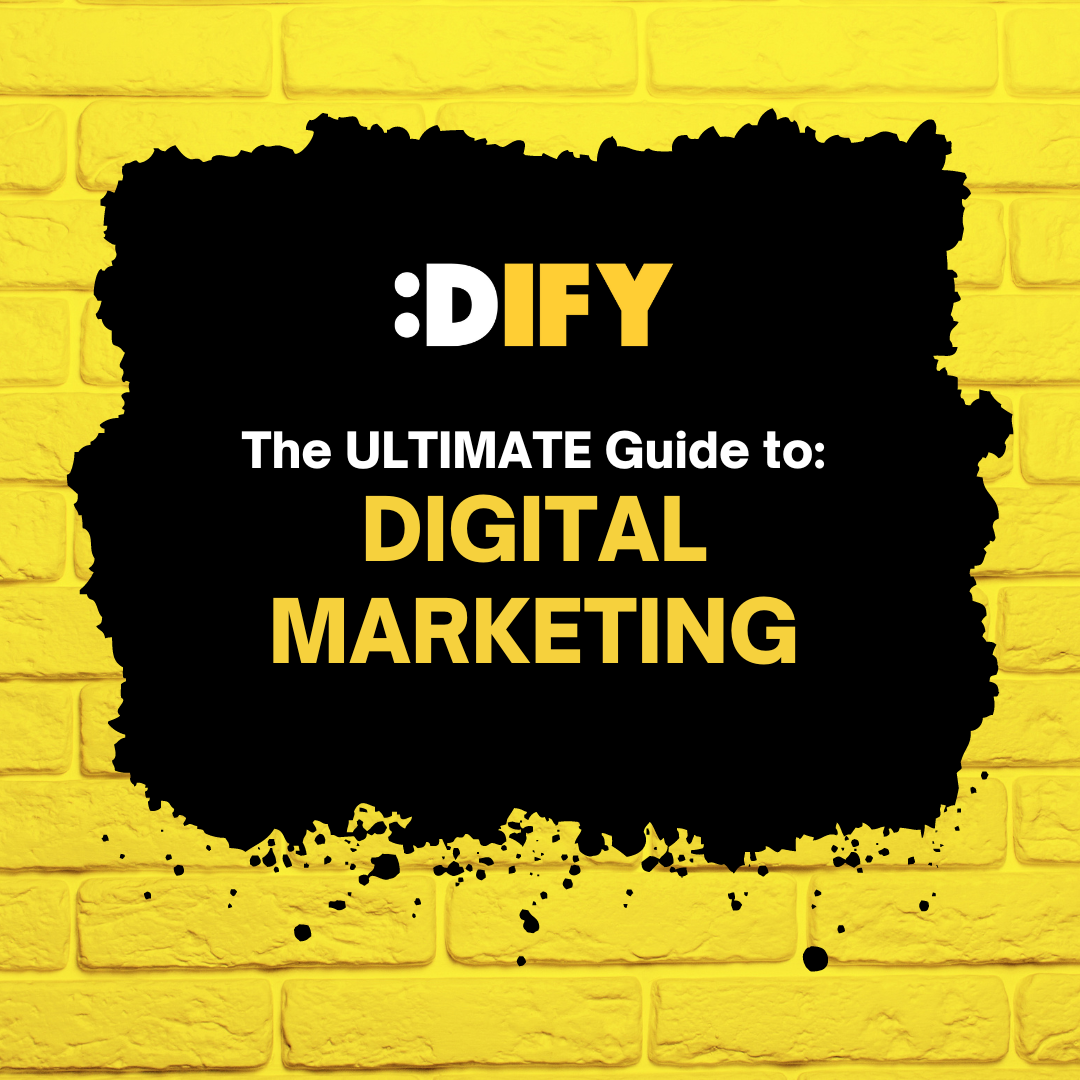DIFY’s Ultimate Guide to Digital Marketing: How to Grow Your Business Online
In today's digital age, businesses must have a strong online presence to succeed. Digital marketing encompasses a wide range of strategies and tactics to help businesses grow and reach their target audience. In this article, we'll cover everything you need to know about digital marketing and how to use it to grow your business.
Table of Contents
What is digital marketing?
The benefits of digital marketing for businesses
Types of digital marketing strategies
Search engine optimization (SEO)
Pay-per-click advertising (PPC)
Social media marketing
Email marketing
Content marketing
Affiliate marketing
Creating a digital marketing plan
Setting goals
Identifying your target audience
Choosing the right channels and tactics
Creating a budget
Measuring the success of your digital marketing efforts
Key performance indicators (KPIs)
Tools for tracking and analysing data
Common digital marketing mistakes to avoid
The future of digital marketing
Conclusion
1. What is digital marketing?
Digital marketing is the use of digital channels, such as search engines, social media, email, and websites, to promote a product or service. The goal of digital marketing is to reach and engage with a target audience, increase brand awareness, and drive website traffic and sales.
2. The benefits of digital marketing for businesses
Digital marketing has many benefits for businesses, including:
Cost-effectiveness: Compared to traditional marketing methods, digital marketing is often more cost-effective and has a higher ROI.
Increased reach: With the internet, businesses can reach a larger audience and target specific demographics.
Better targeting: Digital marketing allows businesses to target specific audiences based on demographics, interests, and behaviours.
Measurable results: Digital marketing campaigns can be tracked and analysed to measure their effectiveness and make data-driven decisions.
Improved customer engagement: Digital channels allow businesses to engage with customers in real-time and build relationships with them.
3. Types of digital marketing strategies
There are many types of digital marketing strategies businesses can use to reach their target audience. Some of the most common strategies include:
Search engine optimization (SEO)
SEO is the practice of optimising a website to rank higher in search engine results pages (SERPs). By optimising for keywords related to your business, you can attract more organic traffic to your website.Pay-per-click advertising (PPC)
PPC is a form of online advertising where businesses pay each time a user clicks on one of their ads. PPC ads can be targeted to specific audiences and can be a highly effective way to drive traffic to a website.Social media marketing
Social media marketing involves using social media platforms, such as Facebook, Twitter, and Instagram, to promote a business and engage with its audience. By creating content that resonates with your target audience, you can build a strong online presence and grow your brand.Email Marketing
Email marketing involves sending targeted emails to a list of subscribers. By providing valuable content and personalised offers, businesses can build relationships with their customers and increase sales.Content Marketing
Content marketing involves creating and sharing valuable content, such as blog posts, videos, and infographics, to attract and engage with a target audience. By providing valuable content, businesses can build trust with their audience and increase brand awareness.Affiliate Marketing
Affiliate marketing involves partnering with other businesses or individuals to promote a product or service. By offering a commission for each sale made through an affiliate's unique link, businesses can expand their reach and increase sales.
4. Creating a digital marketing plan
To create a successful digital marketing plan, businesses must consider several factors, including their goals, target audience, channels and tactics, and budget.
Setting goals
The first step in creating a digital marketing plan is to set clear and specific goals. These goals should align with the overall business objectives and be measurable. Examples of digital marketing goals include increasing website traffic, generating leads, and increasing sales.Identifying your target audience
Once you have set your goals, you need to identify your target audience. This includes understanding their demographics, interests, and behaviours. By understanding your target audience, you can create more effective marketing campaigns and better reach them with your messaging.Choosing the right channels and tactics
After identifying your target audience, you need to choose the right channels and tactics to reach them. This includes selecting the appropriate social media platforms, email marketing software, and advertising platforms. You should also consider which types of content will be most effective for your audience, such as blog posts, videos, or infographics.Creating a budget
Finally, you need to create a budget for your digital marketing efforts. This includes setting aside funds for paid advertising, content creation, and any necessary tools or software. It's important to regularly review your budget and adjust it as needed based on the performance of your campaigns.
5. Measuring the success of your digital marketing efforts
To determine the success of your digital marketing efforts, you need to track and analyse data using key performance indicators (KPIs). Examples of KPIs include website traffic, conversion rates, and social media engagement. By regularly reviewing this data, you can make data-driven decisions to improve your campaigns and achieve your goals.
There are many tools available to help businesses track and analyse their digital marketing data. Google Analytics is a free tool that can track website traffic, user behaviour, and conversions. Social media platforms also provide analytics tools to track engagement and performance of social media posts and ads.
6. Common digital marketing mistakes to avoid
There are several common digital marketing mistakes businesses should avoid, including:
Focusing on quantity over quality: It's important to focus on creating high-quality content that resonates with your audience, rather than just producing a large volume of content.
Not targeting the right audience: Make sure you are targeting the right audience for your campaigns to ensure maximum effectiveness.
Neglecting mobile optimization: With the majority of internet users now accessing content on mobile devices, it's important to ensure your website and content is optimised for mobile viewing.
Failing to track and analyse data: Without regularly tracking and analysing data, businesses risk wasting time and resources on ineffective campaigns.
7. The future of digital marketing
As technology continues to evolve, the future of digital marketing is constantly changing. Some trends to watch for include:
Increased use of artificial intelligence and machine learning to optimise campaigns and personalise content.
Greater focus on user-generated content, such as reviews and social media posts, to build trust with customers.
The rise of voice search and the need for businesses to optimise for voice-based queries.
8. Conclusion
Digital marketing is a crucial component of any successful business strategy in today's digital age. By understanding the different types of digital marketing strategies available, and creating a comprehensive digital marketing plan, businesses can reach and engage with their target audience, increase brand awareness, and drive website traffic and sales.

